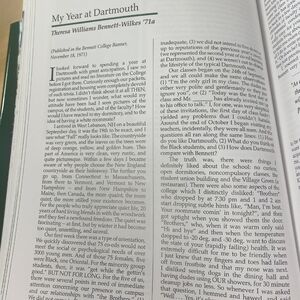Navigating Dartmouth with Triple Jeopardy: Gender, Race, and Resources
Dartmouth remains an unfamiliar environment for some students, especially those from marginalized backgrounds who may not have been introduced to a predominantly white and wealthy setting. This was the case for Wendy Kendrick. She was raised in a close-knit, predominantly Black community, but Dartmouth forced her to face a foreign environment without strong support from family and faculty members.
In being one of only thirty-eight African American women who were accepted to the first co-ed class, Kendrick undeniably faced oppression from multiple angles. That is, she faced oppression due to her racial identity since Dartmouth is a predominantly white institution; she faced oppression due to her gender as one of the first women to attend Dartmouth since its founding; furthermore, she faced oppression due to how she did not receive the same art instruction as her peers, setting her at a disadvantage in attempting to pursue and succeed as an arts major.
Wendy Kendrick '76"I came from a school system that didn't have anything in terms of art department. So it wasn't like I knew the latest in all that. I didn't get that kind of instruction as some of the students got in that department. I didn't have that."
When asked what she wishes Dartmouth provided her during her undergraduate career, Kendrick emphasized mentorship. During the 1970s, the college rarely had any Black professors. Their presence, according to Kendrick, would have benefitted her and other Black students, offering guidance and support from individuals with a shared identity and similar experiences. She did, however, recall an instance when one Black professor, Ashley Bryan, helped her. Bryan took the time to show Kendrick perspective on her drawing pad – the first instance someone directly helped her in the same moment at Dartmouth.
Wendy Kendrick '76"This was four years into my art major and no one had ever taken the time [to directly help me], so I felt like no one really was looking at what I was doing. I was [just] there."
Kendrick finally had someone help her during her senior year at Dartmouth. Unfortunately, she had faced several obstacles beforehand and deemed this experience "too late." It became apparent to Kendrick that her identity as a Black woman remained salient and the injustices she faced prevented her from successfully continuing her art passion for some time.
Wendy Kendrick '76"I just wanted to create and do all this, but I felt like I was being squished... I just struggled with it, I pushed against it, [and] it didn't get me anywhere... It was probably standard for art departments across the country, but that vision of art was not inclusive. It was very white. You know there was no room for what I saw being art. I felt like there was no room for it."
Theresa Williams Bennett-Wilkes '71a"As a Black woman I learned through my Brothers in the wilderness what I must do to perpetuate a strong sense of identity and awareness."



